

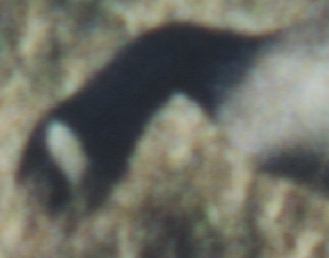
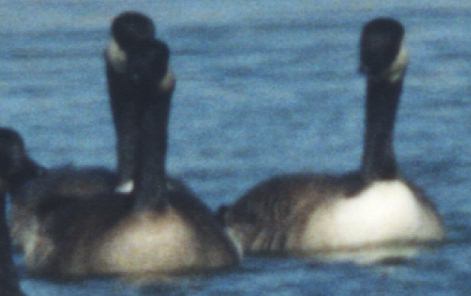


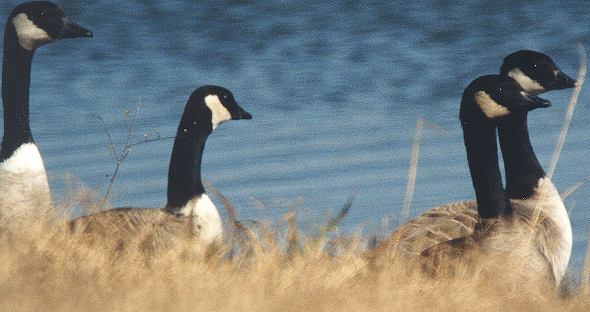

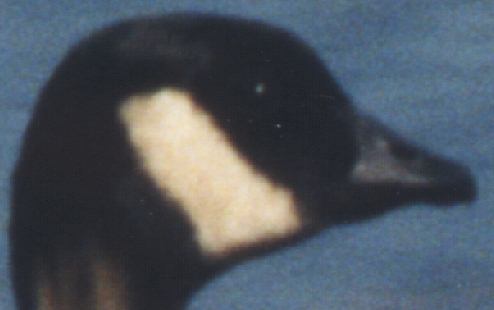
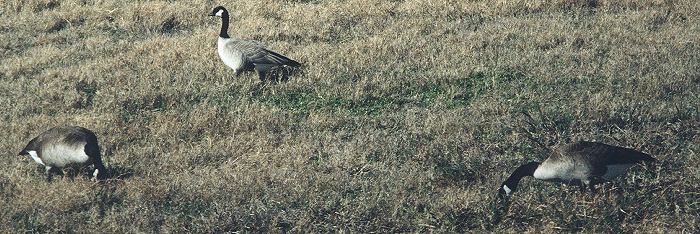
Here is the correspondence from Bruce Deuel, whom
I regard as extremely well-qualified to comment; this first reply
was before I added the three new images on Jan 5:
"I examined your photos of the mystery goose. While I would
have desired better views of the head in profile and the body
plumage (the latter to determine age), I have a couple of contradictory
comments. The color of the bird is within the range for minima.
I'm not sure why the border between the black neck and brown breast
plumage is kinda fuzzy - that's why I was trying to determine
the bird's age. The bill looks bigger (especially longer) than
the average minima. I do not believe the bird to be leucopareia
at all. No neck ring, breast too dark. Of course, if it were a
1st winter bird it could easily be missing a neck ring. I believe,
but this is only from memory, and the last time I handled minima
was in 1989, that a small percentage of birds do show the black
line dividing the chin strap. My bottom line is this bird could
easily be a minima, and if it isn't, I don't know what it would
be."
- then later:
"As far as my experience with minima and leucopareia goes,
between 1973 and
> >1989 I helped trap and band 500 minima a year in the
fall at the Klamath Basin, so I have personally handled several
thousand of them. I also helped trap and band Aleutian geese in
the spring each year from 1977 to the mid-1980s. They were much
harder to trap, so I've probably only handled a few hundred of
them. I've also spent many seasons searching for neck collars
in flocks of both forms. As for ageing these geese, juveniles
have narrower, more trapezoid-shaped body feathers, rather than
parallel-sided, square tipped ones. The breast plumage actually
feels softer in juveniles, and this impression can be noticed
in the field at close range. The color on juvenile minima is more
variable than on adults, but rarely shows the "purple"
cast on the breast that many adults have. There is an irregular
border to the area where the darker breast feathers merge with
the lighter belly feathers. Adult females which have molted back
in their brood patch can show something similar, but on juveniles
any light tipping to the body feathers appears in a more or less
random pattern, while in adults, these light tips tend to be in
rows (kinda Barnacle Goose-like). As I mentioned in my previous
post, where the black neck stocking" meets the back and breast
is more sharply demarcated in adults, and can be "fuzzy"
in immatures. These criteria work for both taxa, except for the
part about "purple" breast feathers, which leucopareia
do not have.
Hope this helps."
- then after I added the new images on Jan 5 and in
response to my statement: " I just looked at my photos that
show the upperparts, and this bird seems to have less-distinct
(less contrasting) pale fringes to the mantle/scaps and especially
the wing coverts compared to most of the hutchinsii, and this
combined with the narrower, duller facial patch leads me to think
it is a juv/first-wnter bird - does that sound right?", Bruce
replied:
"My recollection is that the back and wing coverts also show
the narrower, less square tips. I feel your bird is probably a
first basic."
More comments from Bruce Deuel added
January 21 '00: "I have read with interest all
the comments posted on your web site regarding the small dark
goose you have. I must say first that I have no experience whatever
with hutchinsii; I always assumed that they were close to the
same size as minima. My review of what literature I have indicates
that the average hutchinsii is larger than the largest minima,
but that there is overlap, so if the bird in question is minima,
it's a big one. I still think it looks more like minima than any
other form we see in California. I'm confused by what seem to
be references by other correspondents to leucopareia in Texas
and/or Colorado. This form is restricted to the Pacific Coast;
it is NOT a "lesser," it is the Aleutian Goose. The
literature on Canada Goose subspecies is very confusing and contradictory.
For example, a paper I have that describes, primarily through
measurements, six subspecies that nest in Alaska, states that
taverneri and parvipes (the 2 subspecies we westerners call "lessers")
are both lighter breasted than leucopareia, which is much lighter
than minima. (Johnson, Timm, and Springer, 1979: Morphological
characteristics of Canada geese in the Pacific Flyway; pp 56-76
in Management and Biology of Pacific Flyway Geese, a Symposium
- by the way, Paul Springer is an expert on Pacific Coast Canada
Geese). But Palmer, in the Handbook of N. Am. Birds, says that
"taverneri" represents darker-breasted individuals of
parvipes, and he lumps the two forms. Since parvipes and hutchinsii
overlap in their measurements, your bird could conceivably be
one of these darker taverneri, if they exist! I was really interested
in the comments by the Dutch about minima in with the Barnacle
Geese. We had a Barnacle Goose in with cacklers in California
in 1985-86, and I saw the same bird in Alaska in October of 1986.
Everyone assumed it was an escape, but now I wonder? Incidentally,
both sources I looked at say the black dividing line (on the
shin) is present in most minima."
Comments from others (anonymous unless requested otherwise)
- mostly before I added the new images on Jan 5:
"I hope my trusty "Swans, Geese and Ducks of North America"
by Kortright can shed some light on this ID, with the following
passage: "Cackling" Goose (Branta canadensis minima):
...somewhat smaller than Richardson's Goose [B. c. richardsonii]...coloration
much darker, same as Western Canada Goose [B. c. occidentalis]...
Differs in markings from others of the species in that feathers
of upper chest at base of black 'stocking' are darker than rest
of chest, causing black of neck to merge into colour of lower
neck instead of being sharply demarked as in the other varieties
of this species. White cheek-patches frequently divided by black
of throat; this species is often found with white collar at base
of black 'stocking'." Granted this is an old text (c. 1943),
which is evident by the lack of a split of (B. c. minima) to include
(B. c. leucopareia). Unfortunately, I'm not familiar with subspecies:
interior, moffitti, parvipes, or taverni (as listed in TOS checklist).
So I do not know if this specimen could be of these ssp. From
the illustrations in this book and in NGS3, it looks pretty clear
to me that this is a "Cackling". What I find more odd,
perhaps, is that this ssp. has only been documented once; according
to the last TOS checklist. Is this right? It sounds like there
may have been an accidental switcheroo with the entry for leucopareia
(which is a rare migrant
in central TX?). If you have any answers to these questions, I'm
all ears."
"I think this is not an Aleutian because it lacks the conspicuous white band at the base of the neck, under which there ought to be a thin dark line. These are the most abundant geese where I live and this individual doesn't look like one. What it may be I do not know."
"I checked my copy of Kortright's "The Ducks, Geese, and Swans of North America" and under WESTERN CANADA GOOSE it said this: "white cheek-patches generally divided, or partially so, under throat by black of neck; this feature only occasional with Common Canada Goose." - what do you think??"
"you might also check out a couple of books which, I believe,
depict or describe the subspecies in consideration:
Kortwright & Kortwright. Ducks, Swans and Geese of the World
Palmer. Handbook of North American Birds, vol. 1
Bellrose. Ducks, Geese and Swans of North America
The latter volume has a plate [no. 4] that shows 11 subspecies
of CaGo. The Aleutian [_leucoparia_] shows a definite "chin
line" that splits the white cheek patches, but this plate
also depicts the lesser [_parvipes_] with a similar, but perhaps
slimmer line. In the text, however, Bellrose states [p.142] "..a
white cheek patch that usually covers the throat;" He remarks
earlier about the variation that precludes placement of many individuals
into one of the 11 subspecies. Bellrose also lists the Aleutian
as smaller than the lesser."
"Hi Martin, earlier this fall I saw a few geese in a large flock near Kamloops BC that very closely resembles your bird. I too wondered about its subspecific identification. Interestingly the bird(s) I saw also had a distinct black-feathered area separating the much reduced white cheeks. These were small geese and rather chocolate-brown with some scallopping on the mantle. Although I am not certain what these birds were, I thought they were B.c.minima. I could find no literature mentioning the incomplete white chinstrap."
"Funny, that you are looking for minima, where we in Holland see minima (which we can't count) where we are hoping for hutchinsii (which we can count). Your bird looks quite good for minima, but we usually see them in large flocks of barnacle or sometimes brent geese, which make a bit of a different comparison. I don't know about the black line in the white facial pattern, haven't heard it before, and haven't seen it either. I must say though, I have seen minima's that are almost black, (at least people called them minima) and I don't know how much variation there is. I guess I just don't know."
"In the Netherlands, hutchinsii is rare with about 5 accepted
records now (there is an escape risc of course), so even only
for the hutchinsii the photgraphs are educative. Mimima is relatively
regularly observed in the Netherlands and generally considered
as
escape. In my limited experience with minima type birds, I have
never seen a bird with a breast which is (obviously) paler than
the rest of the underparts, which seems to be more or less the
case in your bird. At least, in particular the breast seems a
bit pale for minima to my eye. If a hutchinsii could be so dark,
I wouldn't know... Birding World published some putative hutchinsii
photographs one or three years ago, which showed rather dark birds
and I do no think these were hutchinsii at all. Please do not
attach too much value to these comments."
From Larry Norris:- "Take a look at Francis H. Kortright,
THE DUCK, GEESE, AND SWANS OF NORTH AMERICA, 1957, The Telegraph
Press, Harrisburg, PA. An old book, but still pretty good write-ups
on the subspecies of Canada Goose. I looked at your photos and
believe the darker goose to be too big for ssp. MINIMA. MINIMA
is the size of a Mallard. However, the rest of your reported field
marks closely match those of MINIMA
1. An overall darker and smaller Canada Goose, compared to nearby
Common Canada Geese. But the bird does not look dark enough for
MINIMA
compared to the other geese in the swimming frames.
2. The white field on the cheeks being divided by a dark line
the
length of the chin. You say Lesser Canada Goose (ssp.LEUCOPAREIA)
has
this mark, but I have never seen in on Lessers, only on MINIMA.
3. The band separating the black neck from the dark-gray breast
(I
have only seen a partial white neck band in MINIMA, never "brownish
copper", and never complete, only in the front of the neck).
The other geese with the darker one in the swimming photos look
like ssp. HUTCHINSI. Light colored and smaller that the nearby
Canada Geese. The size of the darker one is essentially the same,
throwing out ssp. MINIMA. Since the two subspecies do not overlap
in breeding areas a hybrid is really unlikely, but that is what
it looks like to me, a HUTCHINSI x MINIMA cross with the size
of HUTCHINSI, hybridized "dark" areas, hybridized neck
band, and the divided white cheeks of MINIMA.
Any Canada Goose subspecies treatment you read will give you conflicting
information about which subspecies has what field marks. The WATERFOWL
field guide has several more subspecies mentioned, and they many
hybridize, so you may never get a satisfatory answer as to the
actual subspecies of your mystery goose. Godfrey's BIRDS OF CANADA
is not very helpful. The NGS Guide (3rd ed.) plate does not show
all the subspecies of Canada Goose. I have some experience with
MINIMA. I have photographed it in California alongside Mallards,
and I photographed one last April in Colorado, also next to a
Mallard. I see about a half dozen of ssp. LEUCOPAREIA (Lesser
Canada Goose) each year in the state, and have see one already
this year. Lessers in Colorado never have the black chin stripe
separating the white cheeks. MINIMA'S stripe is thin, hardly noticeable
in my experience, difficult to photograph. Your photos showed
a thicker line than I have seen. Again, I stress that these subspecies
hybridize, and books do not treat the subspecies consistently"
"This looks something like an aberrantly very small and fairly dark-breasted B.c. interior of the form found on the north shore of Akimiski I. NWT, which was described and photographed some time ago and pictured on the Rouge River Bird Observatory web site. The form was also discussed extensively by Leafloor, Ankney, and Rusch. 1998. Environmental effects on body size of Canada Geese. Auk 115: 26-33. My apologies if you're already familiar with that, but it's something to consider. I don't believe that this form has the dark chin like yours, but it's interesting to consider. The only other possibility I can think of is a minima/hutchinsii intergrade -- but who knows if these even exist? ."
Added January 21'00: "Sorry
this took me a bit to get back to, but I looked at the pics
and I think the proportion of neck length is not indicative of
species in the small Canada goose clade (leucopareia / hutchinsii
/ minima). I think the light breasted geese might be Lesser (B.
c. parvipes), and the mysterious dark-breasted goose a Taverner's
(B. c. taverneri). I've seen and / or handled most of these species
between birding ponds in Lubbock and Houston, and work with birds
in captivity. Also looked at many a specimen in a museum. I find
the old Peter Scott Book "Wildfowl of the World" to
be most helpful."
Added May 2001 from a reply in March
2001:
"Hi Martin. So long after the event, I can finally comment
usefully on your mystery Canada Geese!! It is indeed a flock
of Lessers (parvipes) with one Taverner's (taverneri).
Attached are a couple of pics of Taverner's, including the only
European record. The parvipes in the photo are too long-necked/billed
to be hutchinsii, and too rangy generally. Taverner's closely
resembles parvipes but is generally a little 'dingier'
with a more compact head/bill, shorter neck in comparison to long
body, and often a black throat divide.
Compared to hutchinsii, Tav's is longer/thinner necked,
more round-headed, longer-bodied, longer-legged, and hutchinsii
should have no throat divide. The dark throat divide is common
to all the smaller and all the darker forms in the west apart
from moffiti(although not all individuals will show it; indeed
only the front bird of the attached pair does, and in the head
shot its reduced to a 'lug' running back from the chin). If the
black divide occurs at all in the eastern forms, it must be very
rare. It is a rather nice 'feel good' factor in several forms
if used in combo with other
features.
Cheers
Richard Millington"
- if I missed anyone's comments, my apologies and please email
me.